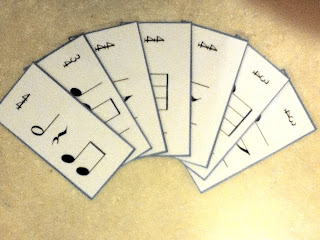
You may be wondering, "What are those?"
Well, they are a very helpful teaching tool I use with my private violin students.
These rhythm cards (as I refer to them), have proven to be very motivating and educational for many of my students!
We as teachers know that each student is unique and different. Each student has their own likes and dislikes about practice time, learning scales, learning technique, drilling challenging measures of music, performance postures, sight reading, and the list goes on and on, and on!
I use the rhythm cards during lessons to help with several situations that come up from time to time.
The first time I introduce these rhythm cards to students is when they start learning how to play their major scales.
After students have a basic understanding of a scale or two, I ask them to memorize the scale(s). During the next lesson, they play the scale for me. We make sure it is in tune,etc., and then they get to pick a card. We talk about the meter and the rhythm on the card they picked. We clap and/or speak the rhythm on the card. Then I ask them to play the rhythm on the card for each note of the scale they memorized that week.
This is such a great way to assess their counting and sight reading skills!
Here's another peek at the various rhythms I introduce on the rhythm cards. These are usually rhythms we're targeting in their pieces as well.

There are a few more ways to incorporate rhythm cards into your private lessons. Be sure to come back tomorrow for another post about rhythm cards and ideas for incorporating them in private lessons!








